Did you know that the average household in the United States emits around 7.5 metric tons of carbon dioxide per year? But fear not, fellow eco-warriors! We have seven energy efficiency tips for eco-friendly living that will help reduce your carbon footprint.
From optimizing lighting and heating to choosing energy-efficient appliances, we’ve got you covered. Let’s join forces and make a positive impact on the planet together.
Lighting
To improve energy efficiency in our homes, we can start by using LED light bulbs instead of traditional incandescent ones. LED bulbs are much more energy efficient and can last up to 25 times longer than incandescent bulbs. They consume less electricity, which leads to lower energy bills and reduces our carbon footprint. Additionally, LED bulbs emit very little heat, making them safer to use and reducing the strain on air conditioning systems.
Another way to enhance energy efficiency is by maximizing natural lighting. During the day, open curtains and blinds to let in natural light, reducing the need for artificial lighting. Utilizing energy efficient bulbs and natural lighting not only saves us money, but also helps us contribute to a more sustainable and eco-friendly environment.
Heating and Cooling
When it comes to heating and cooling our homes, there are a few key points to keep in mind for energy efficiency.
First, it’s important to set our thermostats to recommended temperatures, such as 68°F in the winter and 78°F in the summer, to minimize energy consumption.
Additionally, proper insulation and weatherstripping can prevent drafts and keep our homes at a comfortable temperature without excessive reliance on heating or cooling systems.
Thermostat Temperature Recommendations
We recommend setting the thermostat temperature for heating and cooling to optimize energy efficiency. One of the key energy saving strategies for an energy efficient home is to set the thermostat at an appropriate temperature.
During the winter months, set the thermostat to 68°F (20°C) during the day when you’re at home and lower it by a few degrees at night or when you’re away.
In the summer, set the thermostat to 78°F (25°C) during the day and raise it when you aren’t at home. By adjusting the thermostat temperature, you can save energy and reduce your heating and cooling costs.
Additionally, consider using a programmable thermostat to automatically adjust the temperature based on your schedule, further optimizing energy efficiency.
Insulation and Weatherstripping
One important aspect of energy efficiency for heating and cooling is proper insulation and weatherstripping.
Insulation provides numerous benefits, such as reducing heat loss in the winter and heat gain in the summer. It helps maintain a comfortable indoor temperature and reduces the need for excessive heating or cooling. Good insulation also improves soundproofing, making your home quieter.
Weatherstripping, on the other hand, focuses on sealing gaps and cracks around windows and doors to prevent air leakage. By sealing these areas, you can prevent drafts and save energy that would otherwise be wasted. There are various weatherstripping techniques available, including adhesive-backed foam tape, door sweeps, and caulking.
It’s important to choose the right materials and install them correctly for optimal energy efficiency.
Appliances
To maximize energy efficiency in our homes, it’s essential to carefully select and maintain our appliances. Here are some tips to help you choose energy-efficient appliances and keep them running smoothly:
- Choose appliances with the ENERGY STAR label, which indicates that they meet strict energy efficiency guidelines.
- Look for appliances with energy-saving features such as programmable timers or sensors that adjust settings based on usage.
- Keep your appliances clean and well-maintained to ensure optimal performance. Regularly clean the filters on your air conditioner and dryer, and defrost your freezer when ice builds up.
- Consider upgrading older appliances that aren’t energy-efficient. Newer models are designed to be more energy-efficient and can help reduce your energy consumption.
- Unplug appliances when they aren’t in use to avoid standby power consumption.
Insulation
When it comes to energy efficiency, insulation plays a crucial role in keeping our homes comfortable and reducing our carbon footprint.
Understanding the different types of insulation available, such as fiberglass, spray foam, and cellulose, allows us to make informed choices that suit our budget and needs.
Types of Insulation
We researched various types of insulation to find the most effective and eco-friendly options for our home. Here are five types of insulation materials that can help you save energy and reduce your carbon footprint:
- Fiberglass: Made from recycled glass, fiberglass insulation is affordable, easy to install, and provides excellent thermal resistance.
- Cellulose: Made from recycled paper and treated with fire retardants, cellulose insulation is a sustainable option that offers good thermal performance.
- Spray foam: This insulation material expands when applied and forms an airtight seal, preventing air leakage and providing superior insulation.
- Wool: Made from sheep’s wool, this natural insulation material is renewable, biodegradable, and provides good thermal and sound insulation.
- Recycled denim: Made from recycled denim jeans, this insulation material is free of harmful chemicals and offers good thermal and acoustic properties.
Cost-Effective Insulation Options
For cost-effective insulation options, consider materials such as fiberglass, cellulose, spray foam, wool, and recycled denim.
These cost-effective insulation materials aren’t only affordable but also provide excellent thermal resistance, helping to reduce energy consumption and lower utility bills.
- Fiberglass insulation is commonly used and can be easily installed as a DIY project.
- Cellulose insulation, made from recycled paper, is another cost-effective option that can be blown or sprayed into walls and attics.
- Spray foam insulation is a versatile option that expands to fill gaps and cracks, providing a superior seal.
- Wool insulation, derived from sheep’s wool, is a natural and sustainable choice that offers excellent thermal and acoustic properties.
- Recycled denim insulation is made from discarded denim jeans and provides good thermal insulation while being eco-friendly.
When it comes to cost-effective insulation, these materials offer great value for money and can be installed by homeowners themselves, saving on installation costs.
Benefits of Proper Insulation
Proper insulation offers numerous benefits, including improved energy efficiency and reduced utility costs. Here are five reasons why investing in proper insulation is a smart choice for eco-friendly living:
- Energy savings: Proper insulation helps to regulate temperature, reducing the need for excessive heating or cooling. This leads to significant energy savings and lower utility bills.
- Increased comfort: Insulation creates a barrier that keeps the indoor temperature consistent, making your home more comfortable throughout the year.
- Noise reduction: Insulation not only helps to keep the temperature steady, but it also acts as a sound barrier, reducing noise from outside.
- Health benefits: Insulation improves indoor air quality by preventing the infiltration of dust, pollen, and pollutants, which can have a positive impact on your health.
- Reduced carbon footprint: By using less energy to heat or cool your home, proper insulation helps to reduce your carbon footprint, contributing to a more sustainable environment.
Investing in proper insulation is one of the most effective energy-saving methods that also helps in reducing our carbon footprint.
Water Usage
How can we effectively reduce water usage in our daily lives?
One way is through water conservation practices. We can start by fixing any leaks in our faucets, toilets, or pipes to prevent unnecessary water wastage. Installing low-flow showerheads and faucets can also help reduce water consumption.
Another effective method is rainwater harvesting. By collecting rainwater from our roofs and storing it in barrels or tanks, we can use it for gardening or other non-potable purposes, reducing the need for tap water.
Additionally, being mindful of our water usage habits, such as turning off the tap while brushing our teeth or using a dishwasher instead of handwashing dishes, can make a significant difference.
Renewable Energy
Transitioning to using renewable energy sources is a key step in our journey towards a more sustainable and eco-friendly lifestyle. By harnessing the power of the sun, we can reduce our dependence on fossil fuels and significantly decrease our carbon footprint.
Here are five practical ways to incorporate solar power into our daily lives:
- Install solar panels on our rooftops to generate electricity for our homes.
- Use solar-powered outdoor lights to illuminate our gardens and pathways.
- Invest in solar-powered chargers for our electronic devices.
- Utilize solar water heaters to heat our homes and water.
- Support community solar projects and join a shared solar program.
Conclusion
In conclusion, by implementing these seven energy efficiency tips, we can make a significant impact on the environment while saving money on our utility bills.
From upgrading our lighting to using renewable energy sources, each step we take brings us closer to a more sustainable future. Let’s be proactive in our choices and create a brighter, greener world for generations to come.
Together, we can make a difference.




